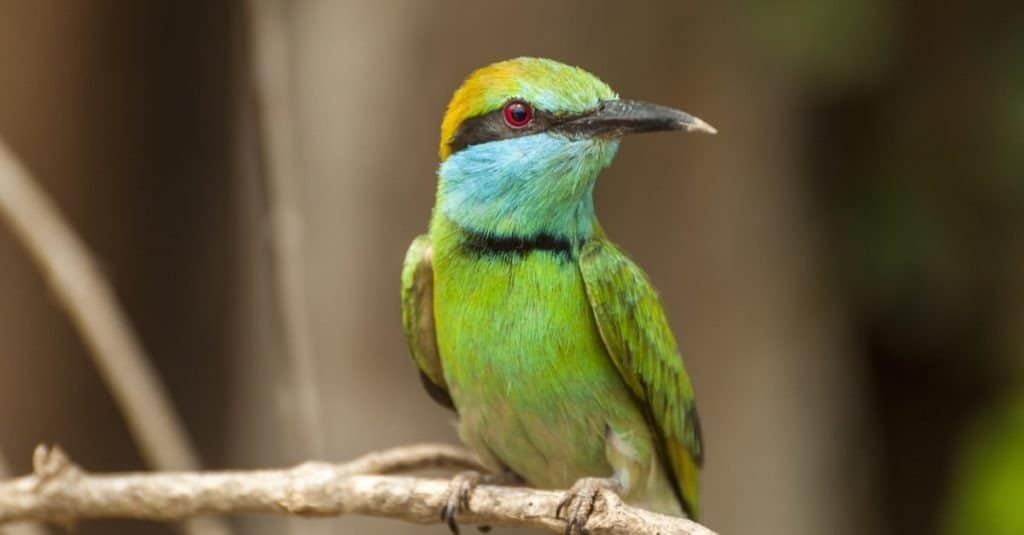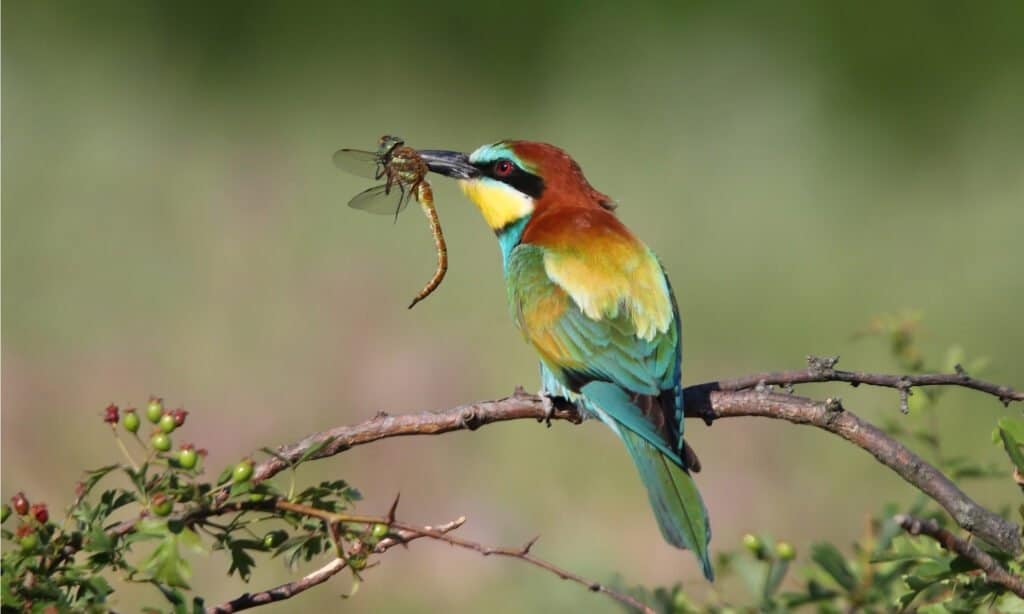Bee-Eater
Nyctyornis amictus, Merops pusillus, and others
They roll around in dirt to prevent external parasites
Advertisement
Bee-Eater Scientific Classification
- Kingdom
- Animalia
- Phylum
- Chordata
- Class
- Aves
- Order
- Coraciiformes
- Family
- Meropidae
- Genus
- Nyctyornis, Meropogon, Merops
- Scientific Name
- Nyctyornis amictus, Merops pusillus, and others
Read our Complete Guide to Classification of Animals.
Bee-Eater Conservation Status
Bee-Eater Facts
- Prey
- insects, including flies, beetles, dragonflies, butterflies, and cicadas
- Main Prey
- Bees and wasps
- Name Of Young
- Chicks
- Group Behavior
- Colony
- Social
- Fun Fact
- They roll around in dirt to prevent external parasites
- Estimated Population Size
- Unknown
- Biggest Threat
- habitat loss, degradation, and climate change
- Most Distinctive Feature
- Long, curved bills
- Distinctive Feature
- green plumage
- Wingspan
- 10 to 20 inches
- Incubation Period
- 20 days
- Age Of Fledgling
- 30 days
- Habitat
- Semi-open woodlands, shrublands, rainforests, and sub-deserts
- Predators
- Birds of prey
- Diet
- Insectivore
- Lifestyle
- Diurnal
- Favorite Food
- honey bees
- Type
- Bird
- Common Name
- Bee-eater
- Special Features
- Pointy beaks
- Location
- Africa, Asia, Europe, and Australia
- Average Clutch Size
- 5
- Nesting Location
- Burrows in the ground or sides of cliffs
- Migratory
- 1
View all of the Bee-Eater images!
“These birds are highly social, roosting together and breeding in colonies.”
Summary
The bee-eater (Meropidae) is a medium-sized non-passerine bird native to Africa, Asia, southern Europe, and Australia. They inhabit a wide range of habitats, from semi-open woodlands to tropical rainforests. They don’t require much more than a perch and a place to dig their burrow. These birds are highly social, often breeding and roosting in large colonies. Find out everything there is to know about this unique bird family, including where they live, what they eat, and how they behave.
5 Amazing Bee-Eater Facts
- Bee-eaters are cavity nesters who dig burrows in the ground or sides of cliffs, often living in large colonies.
- Chicks and adults defecate in their holes and walk on top of it, creating a stench near their nesting sites.
- Their beaks become blunted and shortened while they dig their nesting holes.
- They eat bees and wasps by rubbing them against branches to remove their stingers before consuming them.
- They roll around in the dirt to prevent external parasites. This may also make it easier for them to remove fleas and mites from their feathers.
Where to Find the Bee-Eater
Bee-eaters live across four continents, including Africa, Asia, Europe, and Australia. Most species occur in Africa, but several species inhabit Asia, from India and southern China to the Indonesian islands. Additionally, Europe and Australia each have a single species. These birds don’t have strict habitat requirements; they only need an elevated perch from which to watch for prey and a place to dig their burrows. You can find them in semi-open woodlands, shrublands, forests, rainforests, and sub-deserts. Their habitats are typically near water because riverbanks make good nesting spots. Look for bee-eaters in flocks perched on branches or pruning and sunning themselves on the ground.
Locations
- Africa
- Asia
- Europe
- Australia
Nest
Bee-eaters are cavity nesters who burrow directly into the soil of the ground or the side of cliffs. They nest in colonies, and there may be hundreds of cavities in one area. Males and females dig their burrows using their sharp bills to jab the sand until it loosens. Nest building can take 20 days to complete, and their bills may become blunted and shortened during this time.
Scientific Name
The bee-eater (Meropidae) is a family of non-passerine birds, encompassing three genera and at least 27 species. The name Meropidae, is derived from the ancient Greek word (Merops) for “bee-eater.”
The recognized species of the Meropidae family:
- Red-bearded bee-eater, Nyctyornis amictus
- Blue-bearded bee-eater, Nyctyornis athertoni
- Purple-bearded bee-eater, Meropogon forsteni
- Little bee-eater, Merops pusillus
- Blue-cheeked bee-eater, Merops persicus
- Asian green bee-eater, Merops orientalis
- African green bee-eater, Merops viridissimus
- Arabian green bee-eater, Merops cyanophyrs
- White-throated bee-eater, Merops albicollis
- Swallow-tailed bee-eater, Merops hirundinaeus
- Blue-tailed bee-eater, Merops philippinus
- Black bee-eater, Merops gularis
- Blue-headed bee-eater, Merops muelleri
- Blue-moustached bee-eater, Merops mentalis
- Red-throated bee-eater, Merops bulocki
- White-fronted bee-eater, Merops bullockoides
- Blue-breasted bee-eater, Merops variegatus
- Cinnamon-chested bee-eater, Merops oreobates
- Black-headed bee-eater, Merops breweri
- Somali bee-eater, Merops revoilii
- Böhm’s bee-eater, Merops boehmi
- Blue-throated bee-eater, Merops viridis
- Rufous-crowned bee-eater, Merops americanus
- Olive bee-eater, Merops superciliosus
- Rainbow bee-eater, Merops ornatus
- European bee-eater, Merops apiaster
- Chestnut-headed bee-eater, Merops leschenaulti
- Rosy bee-eater, Merops malimbicus
- Northern carmine bee-eater, Merops nubicus
- Southern carmine bee-eater, Merops nubicoides
Size, Appearance, & Behavior
Bee-eaters are medium-sized non-passerine birds, measuring 7 to 12 inches and weighing 0.5 to 3.0 ounces, with a 10- to 20-inch wingspan. They feature large heads, short necks, short legs, and bright plumage. Their wings may be either pointed or rounded, and those with longer wings are more migratory. Their bills are long and curved with a sharp point, which they use to snatch prey from the air. Most species are at least partially green, and many have black bars through their eyes. Males and females are similar in appearance, and juveniles look a lot like adults.
Bee-eaters are diurnal, although some species may migrate at night depending on the conditions. These birds are highly social, roosting together and breeding in colonies. Their daily rituals include emerging from their nesting holes after dawn, pruning and sunning themselves, and dispersing to feed. Some species participate in social activities even outside of the nesting season. They are also quite vocal, producing simple-sounding notes. However, when studied, they appeared to be rather complex. They live in colonies of five to 200 burrows, which are composed of clans. Each clan consists of two to three pairs, their helpers (male offspring from the previous year), and their offspring.

Bee-eaters use their long, sharp beaks to dig nesting burrows.
©DimLiya/Shutterstock.com
Migration Pattern and Timing
Bee-eaters are medium to long-distance migrants. European species that breed in southern Europe and Asia migrate south to winter in western and southern Africa. Australian bee-eaters are sedentary in the northern parts of their range, but populations in the southern part of the continent will migrate to New Guinea and Indonesia. Several species are intra-African migrants who travel south into rainforest regions during the winter.
Diet
Bee-eaters are insectivores; they hunt by air.
What Does the Bee-Eater Eat?
These birds eat a wide range of insects, including flies, beetles, dragonflies, butterflies, cicadas, termites, crickets, grasshoppers, and moths. Their main prey are wasps and bees, which make up close to 70% of their diet. They will eat a significant amount of honey bees when they are in abundance, especially if their nesting colony is located near an apiary. These birds are aerial hunters, and they perch on exposed branches close to the ground. Small prey is eaten whole, while larger items are taken back to their perch, beaten, and broken into pieces. They rub venomous insects on branches to remove their stingers and venom sacs before consuming them.

Bee-eaters consume insects like wasps, bees, and dragonflies.
©Richard Constantinoff/Shutterstock.com
Predators, Threats, and Conservation Status
The IUCN lists 30 out of 31 species as LC or “least concern.” Due to their extensive range and substantial population sizes, most of the species do not meet “threatened” status thresholds. However, the blue-mustached is NT or “near threatened.” Their population is moderately declining due to habitat loss from timber logging and agricultural encroachment. The primary threats to bee-eaters include habitat loss, degradation, and climate change.
What Eats the Bee-Eater?
Adult bee-eaters are eaten by birds of prey, such as hawks, eagles, and owls. This species uses vocal communications to warn others of potential threats, and males will aggressively defend their nesting sites. Their nest is vulnerable to rodents, weasels, martens, and snakes.
Reproduction, Young, and Molting
Bee-eaters are monogamous during a breeding season, and species that are sedentary in their range may keep the same partner for several seasons. Populations that migrate will often change mates every year. Their courtship displays involve calling while raising their throats and wing feathers. Females lay five white eggs, and both parents incubate them for around 20 days. The chicks are ready to leave the nest after 30 days and can reproduce around one year of age. Their average lifespan is three to six years.
Population
The global bee-eater population is unknown, but the European species alone accounts for over 25 million mature individuals. Eight species have decreasing populations, including the blue-mustached, little bee-eater, northern carmine, purple-bearded, red-bearded, southern carmine, black-headed, and blue-headed. The main reasons for population decline include habitat loss, overexploitation for food, and pesticide use.
Related Animals:
View all 285 animals that start with BBee-Eater FAQs (Frequently Asked Questions)
Where do bee-eaters live?
Bee-eaters live across four continents, including Africa, Asia, Europe, and Australia. Most species occur in Africa, but several species inhabit Asia, from India and Southern China to the Indonesian islands.
Where do bee-eaters build their nests?
Bee-eaters are cavity nesters who burrow directly into the soil of the ground or the side of cliffs. They nest in colonies, and there may be hundreds of cavities in one area.
How big are bee-eaters?
Bee-eaters are medium-sized non-passerine birds, measuring 7 to 12 inches and weighing 0.5 to 3.0 ounces, with a 10 to 20-inch wingspan.
Are bee-eaters social?
These birds are highly social, roosting together and breeding in colonies. They live in colonies of five to 200 burrows, which are composed of clans. Each clan consists of two to three pairs, their helpers (male offspring from the previous year), and their offspring.
What do bee-eaters eat?
These birds eat a wide range of insects, including flies, beetles, dragonflies, butterflies, cicadas, termites, crickets, grasshoppers, and moths. Their main prey items include wasps and bees, which make up close to 70% of their diet.
What threatens the bee-eater?
The primary threats to bee-eaters include habitat loss, degradation, and climate change.
What are bee-eater predators?
Adult bee-eaters are preyed on by birds of prey, such as hawks, eagles, and owls.
Thank you for reading! Have some feedback for us? Contact the AZ Animals editorial team.
Sources
- IUCN, Available here: https://www.iucnredlist.org/search?query=bee%20eater
- San Diego Zoo Library, Available here: https://ielc.libguides.com/sdzg/factsheets/white-frontedbee-eater/behavior

















